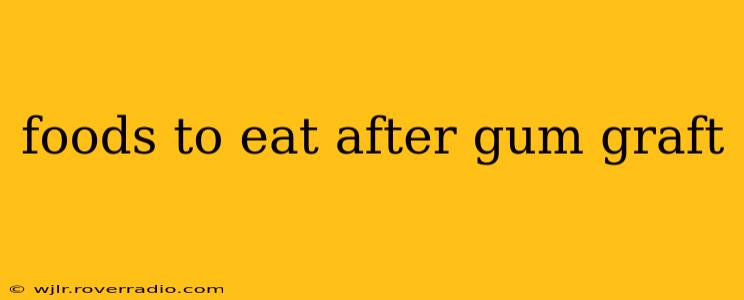A gum graft, also known as a gingival graft, is a surgical procedure used to treat gum recession, where the gum tissue pulls back from the teeth, exposing the roots. Recovery involves careful attention to diet, as certain foods can hinder healing while others promote it. This guide will help you navigate the crucial post-operative dietary phase, ensuring a smooth recovery.
What to Eat After a Gum Graft?
The initial days after your gum graft are critical for healing. Your dentist or periodontist will likely provide specific instructions, but the general recommendation is a soft, liquid, or pureed diet for the first few days, gradually transitioning to softer foods as your mouth heals. Focus on foods that are:
- Easy to chew: Avoid anything that requires significant chewing force, as this can dislodge the graft or cause pain.
- Nutrient-rich: Your body needs proper nutrition to heal effectively. Prioritize foods packed with vitamins and minerals.
- Gentle on the gums: Avoid anything acidic, spicy, or hard that could irritate the healing tissue.
Here's a breakdown of suitable food categories:
Day 1-3 (Liquid/Pureed):
- Smoothies: Blend fruits, vegetables, and yogurt for a nutrient-packed meal replacement. Avoid using straws.
- Soups: Broths, pureed soups (like creamy tomato or vegetable), and well-cooked lentil soups are gentle options. Avoid soups with chunky vegetables or hard noodles.
- Applesauce: Unsweetened applesauce provides essential nutrients without causing irritation.
- Yogurt: Plain yogurt is a great source of protein and probiotics, aiding healing. Avoid yogurt with chunks of fruit.
- Pudding: Smooth, creamy pudding is easy to swallow and digest.
Days 4-7 (Soft Foods):
- Scrambled eggs: Soft, well-cooked eggs are an excellent source of protein.
- Mashed potatoes: Plain mashed potatoes are easy to chew and digest.
- Oatmeal: Cooked oatmeal (without nuts or seeds) is a gentle, nutritious option.
- Pasta: Well-cooked pasta (without hard or crunchy sauces) is acceptable.
- Cooked vegetables: Soft, cooked vegetables like carrots, peas, or spinach can be pureed or mashed for easier consumption.
Weeks 2-4 (Gradually Reintroduce Regular Foods):
As healing progresses, you can gradually reintroduce more solid foods. However, continue to avoid hard, crunchy, or chewy foods for several weeks. Start with softer versions of your regular meals and gradually increase the texture.
What Foods to Avoid After a Gum Graft?
Certain foods should be strictly avoided during the healing process to minimize discomfort and prevent complications:
- Hard foods: Nuts, hard candies, chips, crackers, and raw vegetables can damage the healing graft.
- Acidic foods: Citrus fruits, tomatoes, and acidic juices can irritate the sensitive gum tissue.
- Spicy foods: Spicy foods can cause pain and inflammation.
- Extremely hot or cold foods and drinks: These can cause discomfort and potentially damage the graft.
- Alcohol and smoking: These substances impair healing and increase the risk of complications.
How Long Should I Stick to This Diet?
The duration of your modified diet will depend on the extent of your gum graft and your individual healing rate. Your dentist or periodontist will provide personalized advice. Generally, you can expect to follow a softer diet for at least the first week, gradually introducing harder foods over the following few weeks.
What if I Have Questions or Concerns?
If you experience any complications or have any concerns about your diet or healing process, contact your dentist or periodontist immediately. They can provide specific guidance tailored to your situation. Don't hesitate to reach out – your comfort and successful recovery are their top priorities.
Can I Drink Through a Straw After a Gum Graft?
Generally, it's recommended to avoid using straws after a gum graft. Suction created by using a straw can dislodge the graft or create negative pressure that interferes with the healing process. Stick to sipping from a cup or glass instead.
What About Alcohol and Caffeine After a Gum Graft?
Both alcohol and caffeine should be avoided or minimized in the days following a gum graft. Alcohol can increase the risk of bleeding and inflammation, while caffeine can act as a diuretic, potentially dehydrating you and impacting healing.
Remember, proper nutrition is essential for a successful gum graft recovery. By following these guidelines and communicating with your dental professional, you can significantly enhance your healing experience and improve the long-term outcome of your procedure.
